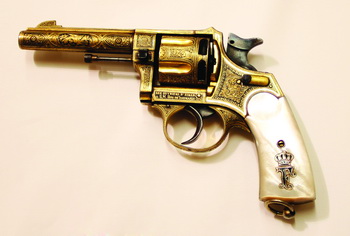Exhibition Presentation
About the Exhibition
From 1997 to today, the Peleș National Museum has organized two exhibitions dedicated to the following royal figures: Queen Maria (2000 and 2004), Queen Elisabeth (1997 and 2009), King Carol I (2006 and 2009) and the most recent, dedicated to King Carol II (2010).

Portrait of Prince Ferdinand Antonio Argnani,
pastel on cardboard, ¼ 20th century
Less visible in the landscape of royalty at Sinaia, Ferdinand I once again paid – metaphorically speaking – the tribute of his lifelong modesty: unusual or even embarrassed to buy or order anything for himself, King Ferdinand left few material traces for posterity. His presence at Sinaia, in his private residence at Pelişor, is totally eclipsed by that of Maria. Pelişor is the product of her highly eclectic artistic experiment. That is why Ferdinand’s personal belongings are few: a few books on botany and fiction, a herbarium from his early youth and a few pieces, a portrait signed by Argnani, his chess set and his riding crop. Fortunately, passionate about photography, Queen Maria talentedly immortalized him in several poses of daily life: at the work table, in the company of family or close friends, on long hikes on the paths of the Sinaia forests.
An additional reason that determined the museographic approach at Peleş is the 95th anniversary of Romania's entry into World War I, with undeniable implications for the destiny of Romania: in August 1916, the Romanian army, led by King Ferdinand I, broke the alliance with the Central Powers to write the most glorious page of national history through the victories at Mărăşti, Mărăşeşti and Oituz, in the summer of 1917, crowned, on December 1, 1918, by the gesture of realizing the centuries-old dream of the Romanian people, Greater Romania.
Destined to be king, Ferdinand I shrouds his person and actions in an almost total mystery. “His life,” says one of his posthumous biographers, Eugen Wolbe, “which was overshadowed by a certain tragedy, was in accordance with the rigor of duty.” Like the man Carol I, whom those interested in national history came to truly know only after the publication of the Private Correspondence in 2005, Ferdinand, the author of a personal diary that has not yet been published, reveals himself to us only from the fragments of memory of others or from the few biographies, more or less inspired, which mainly focus on the king and which oscillate between a slightly condescending tone, obviously critical accents and propagandistic discourse. Despite their subjectivity, the books of contemporaries remain the most credible witnesses to his destiny.

King Ferdinand's revolver atelier
Les Ouvriers D'Eibar, gilded steel, mother of pearl, enamel
National Museum of Romanian History
Complex and profound, the personality of Ferdinand the man, with his charming awkwardness and shyness, his barely concealed lack of enthusiasm for the condition of king and especially with his extraordinary erudition, equaled only by that of Queen Elizabeth of Romania, find their just tone only in Martha Bibescu's much-criticized obituary, "A Royal Sacrifice".
The exhibition aims to reveal to the general public at least one side of Ferdinand the man, through his passions: botany, bibliophily, reading and hunting, without neglecting his quality as a monarch. Numerically limited, King Ferdinand's personal objects will find their true value in a display confirmed by the memoirs of the era.
Organized in two sections, Ferdinand the man and Ferdinand the king, the exhibition brings together pieces of artistic, historical and documentary value, which are part of the heritage of the host museum, but also from the collections of prestigious museums in the capital: the National Museum of History of Romania, the National Philatelic Museum and the National Military Museum "Ferdinand I". Next to the mantle of King Ferdinand I will be copies of the royal crown and the coronation mace, a throne from the late 19th century, the death mask, royal portraits, orders and medals, period photographs, three of the sovereign's uniforms and a valtrap, etc.
One of the most convincing gestures regarding the consideration and respect with which he was regarded by his contemporaries is the donation made to him on January 23, 1884 by the Duchess of Hertzberg, a descendant of the Duke of Hertzberg, the foreign minister of Prussia during the reign of Frederick the Great (1725 – 1795) and the author of a "History of the

Coronation of King Ferdinand I
Alba Iulia, October 15, 1922
National Museum of Romanian History
Secrets of the Berlin Court". The letters date from the period 1747 - 1782 and will be featured for the first time in the exhibition.
Visiting the Exhibition
The exhibition was visited during:
June 24 – September 2, 2011.